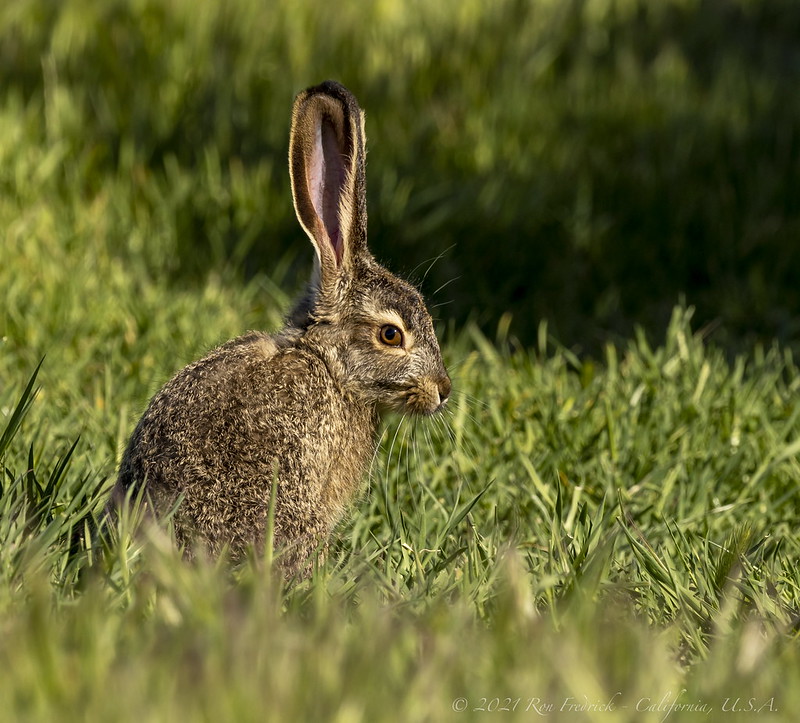Photographed at Shoreline Lake Park, Mountain View, California, U.S.A.
=> Please click on the image to see the largest size. <=
I readily admit to, perhaps, over-appreciating jackrabbits. I enjoyed seeing and chasing after them in fields when I was an 8 year-old kid...even though back then we tried to shoot them with our bows and arrows...launching our arrows at a 45 degree angle to try to intercept the rapidly speeding rabbit. Trust me, none of our arrows ever came within 25 yards of our targets.
I just love the particular look of this rabbit...is it shy...is it curious...do I anthropomorphize my wildlife subjects too much? Yes, I'm sure that's true. 😎
===============
From Wikipedia: The black-tailed jackrabbit (Lepus californicus), also known as the American desert hare, is a common hare of the western United States and Mexico, where it is found at elevations from sea level up to 10,000 ft (3,000 m). Reaching a length around 2 ft (61 cm), and a weight from 3 to 6 lb (1.4 to 2.7 kg), the black-tailed jackrabbit is one of the largest North American hares. Black-tailed jackrabbits occupy mixed shrub-grassland terrains. Their breeding depends on the location; it typically peaks in spring, but may continue all year round in warm climates. Young are born fully furred with eyes open; they are well camouflaged and are mobile within minutes of birth, thus females do not protect or even stay with the young except during nursing. The average litter size is around four, but may be as low as two and as high as seven in warm regions.
The black-tailed jackrabbit does not migrate or hibernate during winter and uses the same habitat of 0.4 to 1.2 mi2 (1–3 km2) year-round. Its diet is composed of various shrubs, small trees, grasses, and forbs. Shrubs generally comprise the bulk of fall and winter diets, while grasses and forbs are used in spring and early summer, but the pattern and plant species vary with climate. The black-tailed jackrabbit is an important prey species for raptors and carnivorous mammals, such as eagles, hawks, owls, coyotes, foxes, and wild cats. The hares host many ectoparasites including fleas, ticks, lice, and mites; for this reason, hunters often avoid collecting them.
Preferred habitat:
The black-tailed jackrabbit can occupy a wide range of habitats as long as diversity in plant species exists. It requires mixed grasses, forbs, and shrubs for food, and shrubs or small trees for cover. It prefers moderately open areas without dense understory growth and is seldom found in closed-canopy habitats. For example, in California, black-tailed jackrabbits are plentiful in open chamise (Ademostoma fasciculatum) and Ceanothus spp. chaparral interspersed with grasses, but does not occupy closed-canopy chaparral. Similarly, the black-tailed jackrabbit occupies clearcuts and early seral coniferous forest, but not closed-canopy coniferous forest.
Predators:
The black-tailed jackrabbit is an important prey species for many raptors and carnivorous mammals. The black-tailed jackrabbit and Townsend's ground squirrel (Spermophilus townsendii) are the two most important prey species on the Snake River Birds of Prey Study Area. Hawks preying on black-tailed jackrabbits include the ferruginous hawk (Buteo regalis), white-tailed hawk (Buteo albicaudatus), Swainson's hawk (B. swainsoni), and red-tailed hawk (B. jamaicensis). The black-tailed jackrabbit is the primary prey of Swainson's, red-tailed, and ferruginous hawks on Idaho and Utah sites. Other raptors consuming black-tailed jackrabbits include the great horned owl (Bubo virginianus), burrowing owl (Athene cunicularia), golden eagle (Aquila chrysaetos), and bald eagle (Haliaeetus leucocephalus). A significant correlation exists between golden eagle and black-tailed jackrabbit reproduction patterns. In Colorado and southeastern Wyoming, black-tailed jackrabbits constitute 9% of nesting bald eagles' diet. Jackrabbits and cottontails (Sylvilagus spp.) combined form 9% of the diet of bald eagles wintering on national forests in Arizona and New Mexico.
_MG_0996fFlkr2
Loading contexts...

